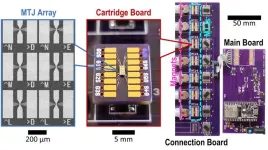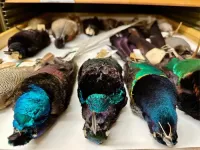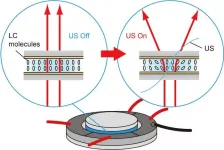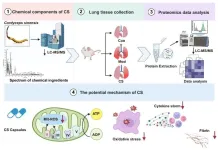(Press-News.org) More and more studies show that men face risks of cancer from BRCA1 and BRCA2 genetic mutations that are most often associated with breast and ovarian cancers in women.
According to a July 25 JAMA Oncology review article by experts at Fred Hutch Cancer Center and University of Washington, newly developed national screening guidelines offer hope for identifying the cancer risk of BRCA mutations in men through genetic testing and tailored cancer screening.
“Not enough men are getting genetic testing to see if they carry a BRCA1 or BRCA2 gene variant that increases their cancer risk," lead author Heather Cheng, MD, PhD, the director of the Fred Hutch Prostate Cancer Genetics Clinic,. “And the men who know they are carriers get tested for their daughters, but don’t always know why it’s important for their own health.”
The article reviews the most recent screening and treatment guidelines for men carrying an inherited damaging variant in two genes, BRCA1 and BRCA2. The review includes updated recommendations for males with a family history of cancer and other risk factors that could help them, and their doctors understand cancer risks.
Men account for 50% of BRCA1/2 carriers and have an increased risk for prostate and other cancers; however current rate of testing for men is only one-tenth of the rate for women. The review refers to “males” as individuals assigned the male sex at birth and cites a study recommending that transgender women and gender neutral and gender fluid carriers of the BRCA1/2 mutations undergo individualized cancer screening based on sex-specific organs.
Because genes are inherited from generation to generation, there is a fifty percent chance that a male carrier of a BRCA1 or BRCA2 mutation shares this mutated gene with their biological offspring. The earlier people are aware of the possibility of carrying a BRCA1 or BRCA2 mutation, the more their medical care can be personalized and tailored to their specific situation: a hallmark of the promise of personalized medicine.
Despite the increased cancer risk for BRCA1 or BRCA2-carrying males, national guidelines on genetic testing and cancer screening have been slower to emerge for males, and national guidelines are now beginning to include more specific measures for males.
With less public awareness of the risk for males carrying BRCA1 or BRCA2 mutations, physicians and other health care professionals may not always be aware of the most up-to-date screening recommendations, which may exist in different places.
Cheng, who treats prostate cancer patients at the South Lake Union clinic at Fred Hutch, noted that programs such as the Fred Hutch Prostate Cancer Genetics Clinic, the GastrointestinaI Cancer Prevention Program and the Breast and Ovarian Cancer Prevention Clinic collaborate to provide comprehensive resources for both patients with cancer and their family members who may also carry increased inherited cancer risk.
“We have multiple programs centered around cancer genetics and prevention that help patients and their families,” Cheng said. “I get to meet the brothers and sons of my patients, some before they have cancer, in order to talk about screening for prostate cancer. And that’s really gratifying. It’s important for folks out there to know that we have these resources because sometimes they don’t know where to go for state-of-the art cancer early detection, prevention and treatment.”
National guidelines for males who carry a BRCA1 or BRCA2 mutation are available at BRCA Research and Cure Alliance and Basser Center for BRCA.
Men should become more proactive about discussing their families’ cancer history with their physician to ensure that they are given access to genetic testing where needed.
Taken together, these actions should help more men understand their lifetime cancer risk, which can lead to earlier cancer detection and better outcomes.
“These are recent guideline changes,” Cheng stressed. “I personally hope that as more people, including males are screened, we can advance progress and research faster, find the people most impacted and work together to reduce the burden of BRCA1 and BRCA2-related cancers.”
Fred Hutch cancer physician and researcher Daniel Lin, MD, contributed to the paper, along with University of Washington professors Mary-Claire King, PhD, and Colin Pritchard, MD, PhD, in tandem with a team of experts from other institutions.
This work was funded by the National Cancer Institute and U.S. Department of Defense.
###
Fred Hutchinson Cancer Center unites individualized care and advanced research to provide the latest cancer treatment options while accelerating discoveries that prevent, treat and cure cancer and infectious diseases worldwide.
Based in Seattle, Fred Hutch is an independent, nonprofit organization and the only National Cancer Institute-designated cancer center in Washington. We have earned a global reputation for our track record of discoveries in cancer, infectious disease and basic research, including important advances in bone marrow transplantation, immunotherapy, HIV/AIDS prevention and COVID-19 vaccines. Fred Hutch operates eight clinical care sites that provide medical oncology, infusion, radiation, proton therapy and related services. Fred Hutch also serves as UW Medicine’s cancer program.
END
BRCA1/2: Why men should be screened for the ‘breast cancer gene’
In men, BRCA1 and BRCA2 gene mutations are associated with greater risk of prostate, pancreatic and breast cancers
2024-07-26
ELSE PRESS RELEASES FROM THIS DATE:
Researchers develop state-of-the-art device to make artificial intelligence more energy efficient
2024-07-26
MINNEAPOLIS / ST. PAUL (07/25/2024) — Engineering researchers at the University of Minnesota Twin Cities have demonstrated a state-of-the-art hardware device that could reduce energy consumption for artificial intelligent (AI) computing applications by a factor of at least 1,000.
The research is published in npj Unconventional Computing, a peer-reviewed scientific journal published by Nature. The researchers have multiple patents on the technology used in the device.
With the growing demand of AI applications, researchers have been looking ...
The Texas Heart Institute provides BiVACOR® Total Artificial Heart Patient update
2024-07-26
Houston, Texas, July 26, 2024 – The Texas Heart Institute (THI), a globally renowned cardiovascular health center, and BiVACOR®, a leading clinical-stage medical device company, are pleased to provide an update on the condition of the first patient to receive the BiVACOR Total Artificial Heart (TAH) implant on July 9, as part of the U.S. Food and Drug Administration (FDA) Early Feasibility Study (EFS). On July 17, eight days following the BiVACOR TAH implant, a donor heart became available and was transplanted into the ...
The ancestor of all modern birds probably had iridescent feathers
2024-07-26
The color palette of the birds you see out your window depend on where you live. If you’re far from the Equator, most birds tend to have drab colors, but the closer you are to the tropics, you’ll probably see more and more colorful feathers. Scientists have long been puzzled about why there are more brilliantly-colored birds in the tropics than in other places, and they’ve also wondered how those brightly-colored birds got there in the first place: that is, if those colorful feathers evolved in the tropics, or if tropical birds have colorful ancestors that came to the region from somewhere else. In a new study published ...
A rare form of ice at the center of a cool new discovery about how water droplets freeze
2024-07-26
Tokyo, Japan – Ice is far more complicated than most of us realize, with over 20 different varieties known to science, forming under various combinations of pressure and temperature. The kind we use to chill our drinks is known as ice I, and it’s one of the few forms of ice that exist naturally on Earth. Researchers from Japan have recently discovered another type of ice: ice 0, an unusual form of ice that can seed the formation of ice crystals in supercooled water.
The formation of ice near the surface ...
Embargoed - Researchers devise novel solution to preventing relapse after CAR T-cell therapy
2024-07-26
Lack of persistence of CAR T cells is major limiting step in CAR T-cell therapy
Made by fusing an immune-stimulatory molecule to a protein from cancer cells, the therapy selectively targets CAR T cells and enhances their functionality and persistence in the body, extending their attack on cancer.
The therapy, called CAR-Enhancer (CAR-E), also causes CAR T cells to retain a memory of the cancer, allowing them to mount another attack if cancer recurs
BOSTON – Even as they have revolutionized the treatment of certain forms of cancer, CAR T-cell therapies ...
Lampreys possess a ‘jaw-dropping’ evolutionary origin
2024-07-26
EVANSTON, Ill. --- One of just two vertebrates without a jaw, sea lampreys that are wreaking havoc in Midwestern fisheries are simultaneously helping scientists understand the origins of two important stem cells that drove the evolution of vertebrates.
Northwestern University biologists have pinpointed when the gene network that regulates these stem cells may have evolved and gained insights into what might be responsible for lampreys’ missing mandibles.
The two cell types — pluripotent blastula cells (or embryonic stem cells) and neural crest cells — are both “pluripotent,” ...
"Just like your mother?" Maternal and paternal X-chromosomes show skewed distribution in different organs and tissues.
2024-07-26
A new study published in Nature Genetics by the Lymphoid Development Group at the MRC Laboratory of Medical Sciences has reveals that the contribution of cells expressing maternal or paternal X chromosomes can be selectively skewed in different parts of the body. The study leverages human data from the 1000 Genomes Project combined with mouse models of human X chromosome-linked DNA sequence variation to advance our fundamental understanding of development in biologically female individuals who have two X chromosomes.
Until now, it was thought that the usage of maternal and paternal X-chromosomes was similar throughout the body. The ...
Conflicting health advice from agencies drives confusion, study finds, but doctors remain most trusted
2024-07-26
Distrust of health experts and credulity towards misinformation can kill. For example, during the Covid-19 crisis, high-profile health experts received death threats while misinformation went viral on social media. And already long before the pandemic, easily preventable but potentially serious diseases had been making a comeback around the world due to vaccine hesitancy – often powered by conspiracy theories.
But what feeds this lack in trust in reliable sources of health information? Can it perhaps be mitigated? Those are the subjects of a new study in Frontiers in Medicine by researchers from the US.
“Here we show that individuals who ...
Towards next-gen indoor lighting: novel tunable ultrasonic liquid crystal light diffuser
2024-07-26
It is no mystery that light is essential to human life. Since the discovery of fire, humans have developed various artificial light sources, such as incandescent lamps, gaslights, discharge lamps, and light-emitting diodes (LEDs). The distribution and intensity of artificial lights indoors are important factors that affect our ability to study and work effectively and influence our physical and mental health. Consequently, modern artificial light sources are designed with these psychological elements to achieve the best aesthetics. ...
Chinese medicinal fungus shows promise in treating idiopathic pulmonary fibrosis
2024-07-26
A recent study from China has reported that Cordyceps sinensis (CS), a traditional Chinese medicinal fungus, can ameliorate idiopathic pulmonary fibrosis (IPF) in mice by inhibiting mitochondrion-mediated oxidative stress. The research, conducted by a team led by Huan Tang and Jigang Wang from the Institute of Chinese Materia Medica at the China Academy of Chinese Medical Sciences, was published in Wiley's MedComm-Future Medicine.
Idiopathic pulmonary fibrosis is a chronic and progressive lung disease characterized by a decline in lung function, ultimately leading to respiratory failure and a significantly reduced quality of life for patients. With a median ...
LAST 30 PRESS RELEASES:
URI researchers uncover molecular mechanisms behind speciation in corals
Chitin based carbon aerogel offers a cleaner way to store thermal energy
Tracing hidden sources of nitrate pollution in rapidly changing rural urban landscapes
Viruses on plastic pollution may quietly accelerate the spread of antibiotic resistance
Three UH Rainbow Babies & Children’s faculty elected to prestigious American Pediatric Society
Tunnel resilience models unveiled to aid post-earthquake recovery
Satellite communication systems: the future of 5G/6G connectivity
Space computing power networks: a new frontier for satellite technologies
Experiments advance potential of protein that makes hydrogen sulfide as a therapeutic target for Alzheimer’s disease
Examining private equity’s role in fertility care
Current Molecular Pharmacology achieves a landmark: real-time CiteScore advances to 7.2
Skeletal muscle epigenetic clocks developed using postmortem tissue from an Asian population
Estimating unemployment rates with social media data
Climate policies can backfire by eroding “green” values, study finds
Too much screen time too soon? A*STAR study links infant screen exposure to brain changes and teen anxiety
Global psychiatry mourns Professor Dan Stein, visionary who transformed mental health science across Africa and beyond
KIST develops eco-friendly palladium recovery technology to safeguard resource security
Statins significantly reduce mortality risk for adults with diabetes, regardless of cardiovascular risk
Brain immune cells may drive more damage in females than males with Alzheimer’s
Evidence-based recommendations empower clinicians to manage epilepsy in pregnancy
Fungus turns bark beetles’ defenses against them
There are new antivirals being tested for herpesviruses. Scientists now know how they work
CDI scientist, colleagues author review of global burden of fungus Candida auris
How does stroke influence speech comprehension?
B cells transiently unlock their plasticity, risking lymphoma development
Advanced AI dodel predicts spoken language outcomes in deaf children after cochlear implants
Multimodal imaging-based cerebral blood flow prediction model development in simulated microgravity
Accelerated streaming subgraph matching framework is faster, more robust, and scalable
Gestational diabetes rose every year in the US since 2016
OHSU researchers find breast cancer drug boosts leukemia treatment
[Press-News.org] BRCA1/2: Why men should be screened for the ‘breast cancer gene’In men, BRCA1 and BRCA2 gene mutations are associated with greater risk of prostate, pancreatic and breast cancers






